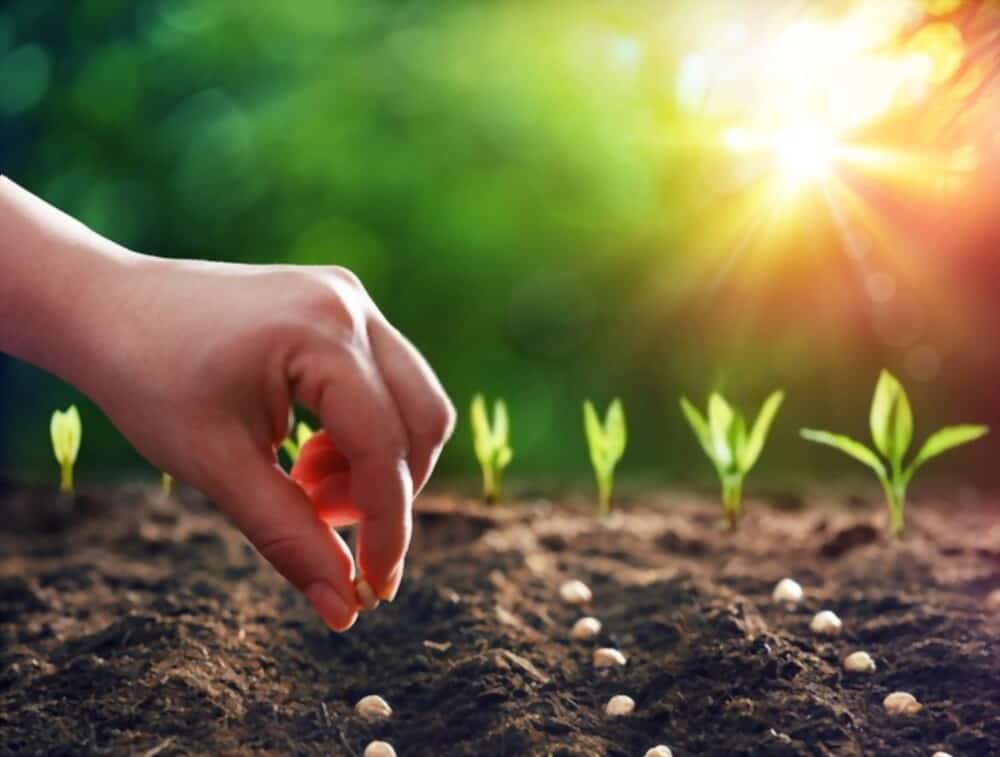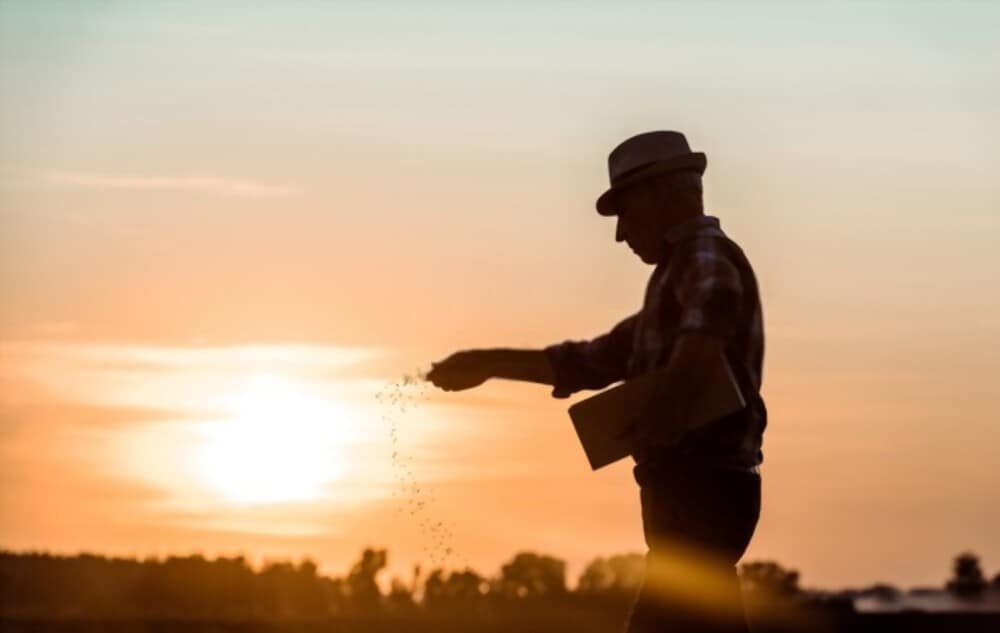Because a number of variables affect how well seeds germinate, there are several possible answers to the question of what depth is optimum for sowing seeds.
The type of soil and the location of the seed planting are two examples of these variables.
Seeds have a better chance of germinating and growing into healthier plants if they are planted 1.5 to 2 inches beneath the soil’s surface. Seeds can receive the appropriate level of warmth, moisture, and aeration at this depth. Seeds are shielded from erosion and pests while they are covered.
The type of soil in which the seeds are sown, the location, and the seed variety can all affect planting depth.
We have discussed how these elements affect seed germination in more detail in this post, along with everything to watch out for in order to grow robust, healthy plants.
Table of Contents
What is the Recommended Depth to Plant Seeds?
We are going to provide a variety of responses to this query.
When seeds are planted too deeply or too shallowly, there are negative effects.
Some seeds should be sown at a deeper depth than others, while others should be sown at a shallower depth.
Despite these variations, there is a depth that is typically advised.
It is advised to bury seeds at least 1.5 to 2 inches deep in the soil.
At this level, seeds can easily obtain the nutrients they need to germinate as planned.
Additionally, drying seeds first before planting is frequently necessary to guarantee proper germination.
To learn how to dry seeds before planting, visit our useful guide.
What Happens if Seeds are Sown Too Deep?
There is a good probability that the plant will become weak, frail, or even fail to germinate when seeds are planted too deeply in the soil.
The warmth, moisture, light, and air that seeds need to germinate may not reach them if they are planted too deeply in the soil.
Some plants have stems that are not intended to firmly push up through the space above them.
This may cause the plant to prematurely die in addition to weakening the stem.
Because of how dense the earth is above the seed when you put seeds in clay soil, the seed may decompose and never germinate.
The seed may struggle to receive enough temperature and aeration, which also delays germination.
What happens if Seeds are Planted too Shallow
You as a farmer could be tempted to plant seeds too deeply so they would grow more quickly.
Regrettably, some plants may have delicate roots that shouldn’t have been seen at germination.
When seeds are planted too shallowly, there is a greater possibility that they will be washed away, carried away by the wind, buried by the soil, or never even begin to grow.
Some plants with various types of roots, such as maize, may not develop properly or grow unevenly.
This may result in the plant’s germination going poorly. Poor yields will arise from the plant’s weak roots, which cannot sufficiently support the plant.
Furthermore, if seeds are planted too shallowly, predators like birds and squirrels may get a hold of them.
Seeds that Can be Planted Shallow
There are some seeds that must be planted shallowly in order to grow successfully, despite some risks.
When seeds are planted too shallowly, they may not have the opportunity to open as they should, which might cause the seed zone to dry up and invite pests to easily access the germinating seed and destroy it.
These seeds are for surface sowing. Most of these seeds require additional sunlight to germinate.
Examples of seeds for surface sowing include:
- Celiac seeds
- Canna seeds
- seeds for Mexican marigolds
- Camaro seed
To ensure that these seeds have easy access to enough sunlight, surface planting is recommended.
What Depth to Plant Seeds
Depending on where you wish to plant the seeds, you may need to sow them at different depths. Plants can be sown in seedling trays, in the ground, or in plant pots.
The depth at which you should sow your seeds may also depend on where you decide to do so.
1. Plant Pots
The bottom of any potted seeds should have drainage holes. For planting seeds, plant pots should be at least one to two inches deep.
Greater densities of smaller seeds can be scattered on the soil’s surface than of larger seeds, which must be buried individually beneath the soil’s surface.
Always keep in mind that the soil used to cover the seeds should be twice as large as the seeds.
There are several nice soil alternatives available if you wish to plant new seeds, but I’ve found that this Miracle-Gro potting soil from Amazon is the most reasonably priced and successful at keeping my plants healthy for a long time after planting. Clicking here will take you there.
2. In the Ground
Once more, everything depends on the kind of seed you plant in the ground.
Similar to what we suggested at the beginning of this post, the typical recommended depth for sowing seeds in the ground is (1.5 to 2 inches).
The seeds have a better chance of developing into healthy seedlings when planted at this depth in the soil, regardless of whether the garden is a raised bed, flat rows, or elevated rows.
3. Seedling Trays
These trays are constructed from foldable plastic material. In the seedling trays, delicate, tiny seeds with a low germination rate ought to be planted.
This shields the seeds from inclement weather that could otherwise kill them.
It is advisable to place seeds in seedling trays at least twice as deep as they are wide.
The seeds should be equally distributed over the surface of the compost, separated by at least 2 cm.
When the seeds have begun to sprout, they can be hydrated by bottom watering, which can encourage the growth of healthier roots.
Can Soil Type Affect Plating Depth?
The depth at which seeds are planted might depend on the type of soil. There are various soil types that you can sow seeds in.
We’re going to examine how the planting depth may vary depending on the type of soil.
We’ll concentrate on the four primary soil kinds, which are;
- Sand soil.
- In clay soil
- Moist soil
- Silty dirt
We will now examine each of the aforementioned soil types to determine how each one impacts the depth at which seeds are planted.
Sandy Soil
Sandy soil is renowned for having larger particles that make it easy for water and air to travel through.
This sort of soil may favor the germination of seedlings that require the aforementioned conditions.
When sowing seeds in sandy soil, one may need to sow them at least twice as deeply as in heavier soil.
This is due to the ease with which sand soil is carried away by water, particularly during rainy seasons.
The sandy soil warms up more quickly on the surface, which is another reason why you should sow your seeds deeper in sandy soil.
Plants can grow deeper into sandy soil where there is more water available than on the surface because it permits roots to do so.
On sandy soil, seeds and plants should be buried deeper.
Clay Soils
Due to its 0.002mm-sized particles, clay soil is widely recognized for being sticky and slowing down the drainage of oxygen and water.
Because clay soil is more compact, roots spread out as they should. Compared to other types of soil, this one holds more water primarily on the surface.
In clay soil, seeds should not be sown deeper than one inch.
Keep in mind that if you cover the seeds too deeply, not enough air and water will be allowed to enter deeply.
Loam Soil
20% clay, 40% silt, and 40% sand soils make up loam soil.
As it has an excellent particle size to air space ratio and allows for enough water and oxygen penetration, this is the best form of soil to grow seeds in.
Additionally, it comprises particles that will enable the roots to grow well and acquire the necessary amounts of oxygen. It also provides for adequate retention of nutrients and water.
In loam soil, seeds should be sown at a depth of 2-3 cm.
Silt Soil
This particular type of soil has fine particles, a high water retention rate that is adequate, and a high fertility rate.
Due to its high fertility level, this type of soil is regarded as the finest for seed planting.
As we mentioned, the usual planting depth in this type of soil is 1.5 to 2 inches.
Final words
In light of everything said above, planting depth is crucial for proper plant germination.
As we learned above, it is often advised to plant seeds at a depth that is double their diameter or width.
Additionally, it’s crucial to carefully follow the instructions on how deep to place the seeds while you’re planting seeds.
The ideal soil to utilize while planting your seeds should also be something that interests you.
This will assist you in determining the depth at which to plant particular seeds based on the soil type you intend to use.
FAQ
What does seed depth mean?
Generally speaking, seeds should be sown at a depth that is double their breadth or diameter. For instance, a seed that is roughly 1/16 inch thick needs to be buried about 1/8 inch deep. It could be necessary to plant large bean seeds, which can be up to 1/2 inch broad, an inch deep.
How do you plant a 1/4 inch deep seed?
What happens if you bury seed too deep?
A seed that is buried too deeply in seed starting soil or garden soil also has difficulty reaching the light. It will deteriorate and die, either inside the soil itself or as its shoot grows. If seedlings are planted too deeply, they may not have stems that can break through the ground.
Why should we sow the seeds at proper depth?
The best course of action is to sow the seeds deeply enough to prevent birds from eating them. The plants won’t have enough room to grow and will compete for resources like nutrients and sunshine if the seeds are planted too closely together.
How deep should you put a seed?
As a general rule, seeds should be sown at a depth that is two or three times their breadth. It is preferable to sow seeds too shallowly rather than too deeply. Certain lettuce varieties and snapdragon seeds, for example, require light to sprout and shouldn’t be covered in any way.


